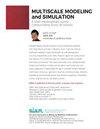随机Schroźdinger方程
IF 1.6
4区 数学
Q2 MATHEMATICS, INTERDISCIPLINARY APPLICATIONS
引用次数: 3
摘要
我们分析了具有低频初始数据和时变弱随机势的Schroźdinger方程的解。我们证明了波场低频分量的均匀化结果。我们还表明,动力学在高频中产生非平凡能量,它不均匀-波场的高频成分仍然是随机的,其能量的演化由动力学方程描述。从低频的均匀化到高频的随机极限的转变是通过理解低频分量的小随机波动的大小来说明的。本文章由计算机程序翻译,如有差异,请以英文原文为准。
The Random Schroźdinger Equation
We analyze the solutions of the Schroźdinger equation with low frequency initial data and a time-dependent weakly random potential. We prove a homogenization result for the low frequency component of the wave field. We also show that the dynamics generates a nontrivial energy in the high frequencies, which does not homogenize---the high frequency component of the wave field remains random and the evolution of its energy is described by a kinetic equation. The transition from the homogenization of the low frequencies to the random limit of the high frequencies is illustrated by understanding the size of the small random fluctuations of the low frequency component.
求助全文
通过发布文献求助,成功后即可免费获取论文全文。
去求助
来源期刊

Multiscale Modeling & Simulation
数学-数学跨学科应用
CiteScore
2.80
自引率
6.20%
发文量
45
审稿时长
6-12 weeks
期刊介绍:
Centered around multiscale phenomena, Multiscale Modeling and Simulation (MMS) is an interdisciplinary journal focusing on the fundamental modeling and computational principles underlying various multiscale methods.
By its nature, multiscale modeling is highly interdisciplinary, with developments occurring independently across fields. A broad range of scientific and engineering problems involve multiple scales. Traditional monoscale approaches have proven to be inadequate, even with the largest supercomputers, because of the range of scales and the prohibitively large number of variables involved. Thus, there is a growing need to develop systematic modeling and simulation approaches for multiscale problems. MMS will provide a single broad, authoritative source for results in this area.
 求助内容:
求助内容: 应助结果提醒方式:
应助结果提醒方式:


